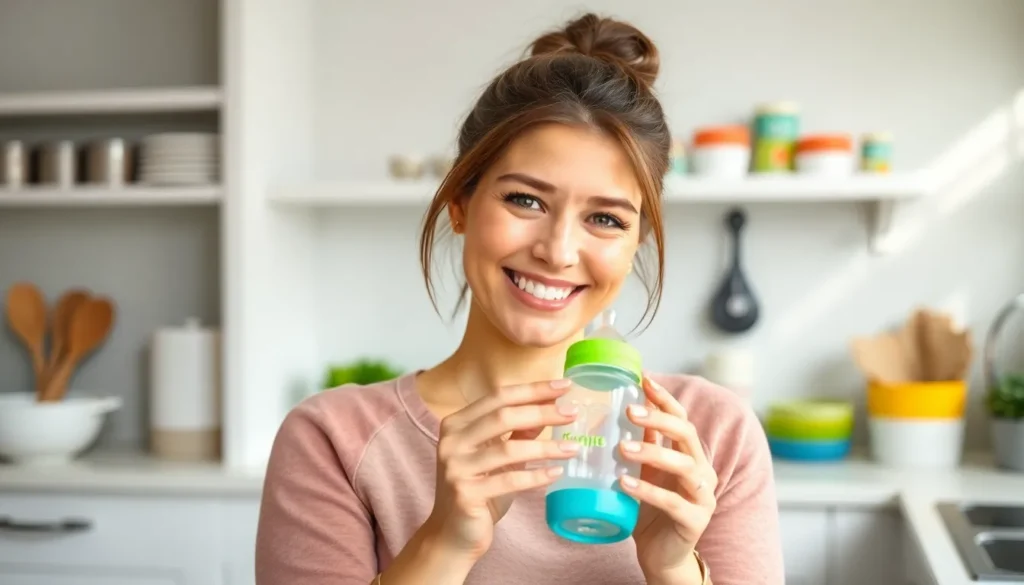Table of Contents
ToggleChoosing the right feeding bottle can feel like navigating a maze blindfolded. With so many options out there, it’s easy to get lost in a sea of nipples, shapes, and materials. But fear not! This guide is here to help parents tackle the bottle battle with confidence and maybe a chuckle or two.
Understanding Feeding Bottles
Selecting the right feeding bottle plays a crucial role in an infant’s feeding experience. Parents face numerous choices, making understanding essential.
Types of Feeding Bottles
Parents can choose from several bottle types designed for various feeding methods. Standard bottles suit most babies, while wide-neck bottles ease cleaning and filling. Some bottles mimic breast shapes, promoting easier breastfeeding transitions. Other options include anti-colic bottles which reduce air intake during feeding, potentially minimizing gas issues. Specialty bottles designed for premature infants employ specific flow rates to meet unique needs. Familiarizing with these choices simplifies the selection process.
Materials Used in Feeding Bottles
Feeding bottles are crafted from diverse materials, each with distinct benefits. Glass bottles offer durability and are easy to clean. BPA-free plastic provides lightweight convenience. Silicone bottles are flexible and collapse without spills. Stainless steel options combine insulation with sturdiness, preventing breaks. The choice of material influences the bottle’s weight, ease of cleaning, and safety. Understanding these materials assists in selecting bottles that align with lifestyle and safety requirements.
Choosing the Right Feeding Bottle

Selecting the right feeding bottle involves several crucial considerations. Parents must evaluate the unique needs of their infants alongside the options available.
Factors to Consider
Nipple shape impacts feeding preferences. Some infants prefer bottle nipples that mimic the breast, while others may adapt to standard or wide-neck designs. Flow rates of nipples contribute to comfort during feeding. A slow flow suits newborns, while active feeders might require faster options. Material choice also holds significance; parents can choose glass for durability or BPA-free plastic for lightweight handling. Anti-colic features may lessen gas discomfort, proving beneficial for sensitive infants. Cleaning efficiency should factor into the selection as well, as bottles frequently used need straightforward maintenance.
Popular Brands and Recommendations
Parents often turn to brands like Dr. Brown’s and Philips Avent for reliable choices. Dr. Brown’s specializes in anti-colic technology, reducing gas and fussiness during feeding. Philips Avent offers a range of options, including breast-like nipples to ease transitions. Comotomo features soft silicone bottles, appealing to many infants due to their natural feel. Consider Tommee Tippee for ease of grip and a wide range of flow rate options. Each brand presents unique advantages, catering to diverse feeding preferences and requirements.
Proper Use of Feeding Bottles
Proper use of feeding bottles significantly enhances the feeding experience for both infants and parents. Understanding how to clean and maintain bottles and ensuring safety standards can provide peace of mind during feeding times.
Cleaning and Maintenance
Cleaning feeding bottles carefully prevents bacterial growth and maintains hygiene. Rinse bottles and nipples immediately after use to remove milk residue. Utilize warm, soapy water or a bottle brush to clean every accessible part thoroughly. Sterilization options include boiling, steaming, or using a dishwasher on the highest setting. Regular replacements of nipples, especially if worn or damaged, help preserve safety and optimal function.
Safety Tips for Feeding Bottles
Safety remains a top priority when using feeding bottles. Always check for signs of wear, such as cracks or chips, before each use. Choose BPA-free materials to eliminate potential health risks. Avoid leaving a baby unattended with a bottle to minimize choking hazards. Properly store bottles in a clean, dry area away from direct sunlight, which can degrade some materials. Opting for bottles designed with anti-colic features can enhance comfort by preventing gas buildup during feeding.
Benefits of Feeding Bottles
Feeding bottles offer numerous advantages for both infants and parents. Understanding these benefits aids in making informed choices during the selection process.
Convenience for Parents
Convenience stands out as a key benefit of feeding bottles. Bottles allow caregivers to feed infants without direct breastfeeding, providing flexibility in feeding times. Parents can easily prepare milk or formula in advance, which supports busy lifestyles. Nighttime feedings become simpler when parents can hand off the bottle to partners or caregivers. Different bottle designs also enhance comfort during feeding, allowing for various holding positions. Cleaning and sterilizing feeding bottles can be straightforward, particularly with those designed for easy disassembly.
Feeding Options for Infants
Feeding options diversify significantly with the use of bottles. Various nipple shapes and flow rates ensure comfort for all infants, meeting their individual needs. Slow-flow nipples cater to newborns, while faster options accommodate older infants who are more adept at feeding. Specially designed bottles for premature infants address unique feeding challenges, promoting a smoother feeding experience. In addition, parents can introduce different types of milk, such as breast milk or formula, facilitating it for infants with dietary restrictions or preferences. Overall, bottles provide versatile feeding solutions that can adapt to the evolving needs of growing babies.
Choosing the right feeding bottle is a vital step in ensuring a smooth feeding experience for both infants and parents. With a variety of options available parents can find bottles that suit their baby’s needs while also fitting their lifestyle. Understanding the unique features of different bottles and materials empowers parents to make informed decisions.
By considering factors like nipple shape flow rate and ease of cleaning parents can select a bottle that enhances their baby’s comfort and feeding efficiency. With the right guidance navigating this maze of choices becomes manageable. Embracing the journey of finding the perfect feeding bottle not only benefits the baby but also brings peace of mind to caregivers.





